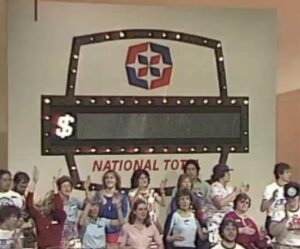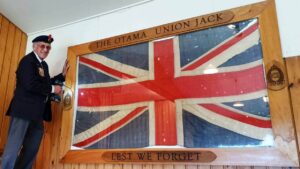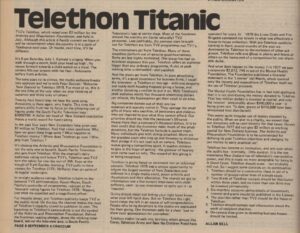1975: Telethon
October 16, 2021
By AHNZ
 The New Zealand Telethon was a cynical, shallow, derivative, televised out-letting of psudo-community spirit than ran from 1975 to 1991. During this period it was the vehicle of South Pacific Television/TV2 who discarded it as having run its course. In 1993 TV3 picked Telethon up out of the rubbish skip and has run one from time to time.
The New Zealand Telethon was a cynical, shallow, derivative, televised out-letting of psudo-community spirit than ran from 1975 to 1991. During this period it was the vehicle of South Pacific Television/TV2 who discarded it as having run its course. In 1993 TV3 picked Telethon up out of the rubbish skip and has run one from time to time.
Under the pretense of various good causes various groups cashed in on the opportunity to advertise to the public at the same time as picking their pockets. The cause was always a distant second to the feel-good self-congratulatory festive atmosphere. The organiser of the first eight Telethons (1975-1983) Don Hutchings, admits that, “We sublimated the cause and promoted the festival..we could do a Telethon for a 3-legged dog..”!
You’ve got to remember that these are just simple 1970s Kiwis. These are people of the land. The common clay of the South Pacific. Our parents and grandparents.
“Telethon is giving based on sentiment not on informed concern. Telethon 1978 was a unique opportunity to inform the largest number of New Zealanders ever involved in a single media event, about arthritis and rheumatism and their alleviation. The nearest we got to information was a few cursory interviews with child sufferers, used – as one interviewer so aptly put it- as ‘mascots’.” – Allan Bell (1978)
Allan Bell (presumed to be socio-linguistics Professor Emeritus Alan Bell of AUT) wrote a scathing review of Telethon in the 1978 issue of Auckland University’s student magazine Craccum. TV2 at this time was in the same ratings-trailing territory as TV3 is in our own time. Both networks resorted the same device: “Telethon is a balm…controller of programmes, rejoiced at the ‘buoyant’ rating figures for Telethon 1987: ‘Massive, just what we expected and a magnificent effort.’..Behind the frontmen reading pledges, above the winking total-board, behind the interview area, is South Pacific Television’s logo at center stage. Most of the frontmen are…TV2 personnel…overseas stars brought out for Telethon are from TV2 programmes..” So much for why TV2 or TV3 would put on this show.
 Advertisers, as Bell also educates us, do brilliantly out of jumping on board the cause of the day. The advertising coverage that a firm receives for being part of the TV charity event is substantial and they get to directly market their widget or service, perhaps giving it out as a prize. Far from advertising, it will be perceived by the public as self-less generosity. The tax man will see it the same way. Here’s advertising disguised as a pre-tax charitable write-off.
Advertisers, as Bell also educates us, do brilliantly out of jumping on board the cause of the day. The advertising coverage that a firm receives for being part of the TV charity event is substantial and they get to directly market their widget or service, perhaps giving it out as a prize. Far from advertising, it will be perceived by the public as self-less generosity. The tax man will see it the same way. Here’s advertising disguised as a pre-tax charitable write-off.
An economist would point out that the Telethon has a Crowding Out effect toward other organisations not favored by the nomination of the TV producer fairy godmother. The Salvation Army, Lions, Rotary, Save The Children and various causes are up-staged by the televangelists behind one monolithic recipient.
Telethons were, and are, about sentiment rather than informed concern. They are a phenomena of Group Think which explains why they were so popular during the years when that shallow generation, the Baby Boomers, came of age. A similar phenomena occurred when the similarly facile Millennials came of age and broke out the Give A Little and I Am Hope online versions of Telethon in the mid-late twenty teens decade.
Technically, the first Telethon was on 25 April, 1945, with telephones and radio set to raise funds on a “Dominion-wide basis” during the War. This raised over $5,000,000 to help our soldiers at a time when many of them were Prisoners of War and many were simply left high and dry by a government that was quick to send them out but slow to bring them home. By the time TV2 gave Telethons the flick they were bringing in less revenue that our 40s counterparts. The elders of the 1940s frowned on the Telethon of their day, the Returned Service Association gravely disappointed that “sanctity” was being exchanged for “salesmanship.” The Protection of the Word ANZAC Act (1920) Crowded Out any commercial exploitation of ANZAC but here it was being done and the old timers didn’t like it.
“Telethon makes giving a competitive sport. It teaches children to give in the hope of getting- the glamour of hearing your name read on telly. The reward of this giving is in being recognised.” – Bell
“We feel that the sanctity of the commemoration, which is the very core of Anzac Day, and which the legislation of the country framed specifically to protect, will be grossly violated by the high pressure salesmanship involved in the proposed radio telephone appeal for patriotic funds which is planned for Wednesday evening,” said Mr. A P Postlewaite, president of the Auckland RSA, this morning. The proposal, he said, was a wilful breach of the spirit of the Act, and the emotions of the community would be cruelly offended.” – Evening Post (1945); Furore over Anzac Day radio appeal, 1945, Timespanner (2011)
 During the 1978 Telethon a frontman even called out for a general cheer for the audience to show appreciation for itself. This is very Boomer but flying in the face of the sentiments of older generations of New Zealander for whom charity was about giving not receiving. For example, the RSA and Silent Generation phenoema of the Jaycees simply rolled up their sleeves and gave and gave without any self-publicity. Perhaps that’s why the Jaycees are gone and forgotten now, apart from the surviving public works all over New Zealand? Timespanner thinks it odd the old timer RSA guys sold ANZAC poppies but balked at a radio-telephone Telethon in ’45. I can see that it’s a big change in sentiment from a simple and somber flour in one’s lapel to an all-singing-all-dancing-celebrity-imported-televised extravaganza.
During the 1978 Telethon a frontman even called out for a general cheer for the audience to show appreciation for itself. This is very Boomer but flying in the face of the sentiments of older generations of New Zealander for whom charity was about giving not receiving. For example, the RSA and Silent Generation phenoema of the Jaycees simply rolled up their sleeves and gave and gave without any self-publicity. Perhaps that’s why the Jaycees are gone and forgotten now, apart from the surviving public works all over New Zealand? Timespanner thinks it odd the old timer RSA guys sold ANZAC poppies but balked at a radio-telephone Telethon in ’45. I can see that it’s a big change in sentiment from a simple and somber flour in one’s lapel to an all-singing-all-dancing-celebrity-imported-televised extravaganza.
Telethons today cannot rival the ones New Zealand saw from 1975 to 1991 for cultural reasons as well as technological. They reached peak revenue in 1985 and peak production values in 1988 (Ref. “…each telethon outdid the previous total for several years, peaking in 1985…The largest undertaking including smaller regional centres with host locations was 1988.” – wiki) From the mid 1970s the Boomers had moved on from their hippy-dippy-Nambassa-flower-power-commune period and received Telethons as the new civic receptacle for their energy. If there were any detractors of the 1945 RSA sort then they were swept away in the new era of colour television (1974) and energetic on-tv enthusiasm that also gave us Top Town (1976.)
 This is for the best. As Bell wrote in Craccum (see full article below) it wasn’t clear where the money was going anyway. It had become more about The Show than the ‘mascots’ rolled out as a fig leaf for all the advertising and ratings spectacle. How odd it must have felt to the visiting celebrities collecting their pay cheques for being flown it for the primitive carnival of New Zealanders to fawn and spill their fiat currency over?1 A dangerous trend was emerging by 1988 of trying to use Telethons to propagandise the public into thinking and behaving a certain way. In A City Possessed (2001) Lynley Hood pointed out that Telethon 1988 “Spread sexual abuse anxiety throughout the community.” New Zealanders were assured that sexual violence toward children was rampant by the most expansive Telethon production the country had seen before or since.
This is for the best. As Bell wrote in Craccum (see full article below) it wasn’t clear where the money was going anyway. It had become more about The Show than the ‘mascots’ rolled out as a fig leaf for all the advertising and ratings spectacle. How odd it must have felt to the visiting celebrities collecting their pay cheques for being flown it for the primitive carnival of New Zealanders to fawn and spill their fiat currency over?1 A dangerous trend was emerging by 1988 of trying to use Telethons to propagandise the public into thinking and behaving a certain way. In A City Possessed (2001) Lynley Hood pointed out that Telethon 1988 “Spread sexual abuse anxiety throughout the community.” New Zealanders were assured that sexual violence toward children was rampant by the most expansive Telethon production the country had seen before or since.
Judy Bailey and Natalie Brunt didn’t create the 1990s Moral Panic (and corresponding man-hating/anti-father climate to follow) in their off-shoulder tango frocks but they gave it a damn good push. Perish the thought that Telethons should ever rise again least they be put to similar nefarious purposes.
—
1 Perhaps Leeza Gibbons married fellow fly-in Christopher Quinten for c.2 years as a way to make the lie of their on-air kiss true? There was a huge truth-deficit going on and maybe a wedding was needed for moral ballast to all the fakery?
Image ref. Judy Bailey and Natalie Brunt introduce Telethon 1988, slydogmania, Youtube
Ref. Telethon Titanic, Allan Bell, p8 Craccum (September 1978)
Note: Allan Bell the socio-linguistics professor was editor of Craccum himself in 1976 so I’m quite confident I’ve found my man. If I can find an email address I’ll ask him what he thinks about what he said back then and report back here.
Update November 2021: Received a reply from Bell..
On 2021-10-19 21:43, Allan Bell wrote:
> Hello Rick
>
> Glad to hear you found that piece stimulating. In answer to your
> question, yes I would stand by what I wrote 40 years ago, the
> principles remain the same even though the specific form is no longer
> with us. Presumably your post has been triggered by the recent
> ‘Vaxathon’, but I am only too happy to see the telethon format
> adapted for that purpose.
>
> I don’t actually remember the piece appearing in Craccum
> (‘Telethon Titanic’ certainly wasn’t my headline). I was living
> in Wellington at the time and submitted it to the Dominion or the
> Evening Post, and I’m pretty sure they published a version of it. It
> was partly stimulated by my knowing a number of people working in the
> voluntary sector who commented on the adverse effect telethon had on
> support for non-targeted charities.
>
> I am intrigued – though not particularly surprised – that an
> Anarchist and a Christian should come to similar conclusions on a
> cultural event like telethon!
>
> Allan
 Like Comment Share
Like Comment Share






